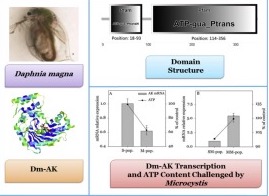Keyword: Cyanobacterial blooms

Lyu, K., L. Zhang, X. Zhu, G. Cui, A. E. Wilson, and Z. Yang. 2015. Arginine kinase in the cladoceran Daphnia magna: cDNA sequencing and expression is associated with resistance to toxic Microcystis. Aquatic Toxicology 160:13-21.
Abstract
Nutrient loading derived from anthropogenic activities into lakes have increased the frequency, severity and duration of toxic cyanobacterial blooms around the world. Although herbivorous zooplankton are generally considered to be unable to control toxic cyanobacteria, populations of some zooplankton, including Daphnia, have been shown to locally adapt to toxic cyanobacteria and suppress cyanobacterial bloom formation. However, little is known about the physiology of zooplankton behind this phenomenon. One possible explanation is that some zooplankton may induce more tolerance by elevating energy production, thereby adding more energy allocation to detoxification expenditure. It is assumed that arginine kinase (AK) serves as a core in temporal and spatial adenosine triphosphate (ATP) buffering in cells with high fluctuating energy requirements. To test this hypothesis, we studied the energetic response of a single Daphnia magna clone exposed to a toxic strain of Microcystis aeruginosa, PCC7806. Arginine kinase of D. magna (Dm-AK) was successfully cloned. An ATP-gua PtransN domain which was described as a guanidine substrate specificity domain and an ATP-gua Ptrans domain which was responsible for binding ATP were both identified in the Dm-AK. Phylogenetic analysis of AKs in a range of arthropod taxa suggested that Dm-AK was as dissimilar to other crustaceans as it was to insects. Dm-AK transcript level and ATP content in the presence of M. aeruginosa were significantly lower than those in the control diet containing only the nutritious chlorophyte, Scenedesmus obliquus, whereas the two parameters in the neonates whose mothers had been previously exposed to M. aeruginosa were significantly higher than those of mothers fed with pure S. obliquus. These findings suggest that Dm-AK might play an essential role in the coupling of energy production and utilization and the tolerance of D. magna to toxic cyanobacteria.